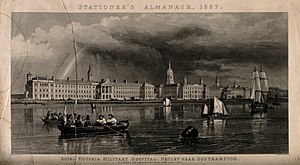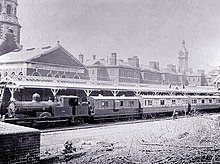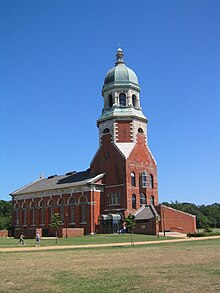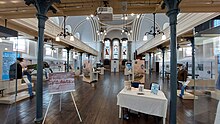Netley Hospital
| Netley Hospital | |
|---|---|
 Line engraving of Royal Victoria Military Hospital from Southampton Water produced by T. A. Prior in 1857 | |
| Geography | |
| Location | Netley, England, United Kingdom |
| Coordinates | 50°51′59.73″N 1°20′30.29″W / 50.8665917°N 1.3417472°W |
| Organisation | |
| Care system | Public NHS |
| Type | Public |
| Services | |
| Emergency department | No Accident & Emergency |
| History | |
| Opened | 1856 |
| Closed | 1978 |
| Links | |
| Lists | Hospitals in England |
The Royal Victoria Hospital or Netley Hospital was a large
The hospital was situated within the larger area of land bounded by the River Itchen and River Hamble, particularly around Sholing[1] that had become known locally as Spike Island. That term was subsequently used by wounded soldiers and prisoners of war to describe the location of the hospital.
History
Development
This stone was laid on the 19th day of May in the year of our Lord 1856, by Her Most Gracious Majesty Victoria, Queen of Great Britain and Ireland as the foundation stone of the Victoria Military Hospital intended for the reception of the sick and invalid soldiers of her Army[6]
Some confusion was caused by the publication in and politicise them. In January 1857, Prime Minister Lord Palmerston wrote:
It seems to me that at Netley all consideration of what would best tend to the comfort and recovery of the patients has been sacrificed to the vanity of the architect, whose sole object has been to make a building which should cut a dash when looked at from Southampton River. Pray stop all work.[8]
But construction was well under way, and it was too late to change the design significantly.[8] Subsequent reports and enquiries concluded that the design and its location were indeed flawed,[9] though, under the influence of Dr John Sutherland, Nightingale eventually expressed approval for the plans.[10]
The hospital eventually opened for patients on 11 March 1863.[11] It was a quarter of a mile (435 m) long, had 138 wards and approximately 1,000 beds, and was Britain's largest military hospital. It cost £350,000 to build, and was late and over budget. Supporting infrastructure was also built, including a reservoir at Hound Grove[4] and a gasworks[8][12] In 1863 Nightingale's colleague Jane Catherine Shaw Stewart became the Supervisor of Nurses, but she was there for just five years before an investigation revealled her bullying and temper.[13] She was replaced by Jane Cecilia Deeble who was awarded the Royal Red Cross for her work "in Zululand". Deeble was in charge until 1889 when she was succeeded by Helen Campbell Norman.[14]
A cast iron pier was extended into Southampton Water in 1865,
In 1864, a Portland stone memorial was erected, dedicated to the members of the Army Medical Department who died in the Crimean War.[15]
Early use

The building was enormous, grand, and visually attractive, but was neither convenient nor practical. Corridors were on the sea-facing front of the building, leaving the wards facing the inner courtyard with little light and air. Ventilation in general was poor, with unpleasant smells lingering around the vast building. In 1867, journalist Matthew Wallingford paid a visit to the hospital to write a report for the local parish newsletter:
It was a ghastly display of deception to say the least. To the naked eye it is a triumph of modern architecture, but should you inherit the misfortune to be sectioned there, one would not think of the place as so. It is not so much as the greatest military hospital in the world as much as it is a rather impractical waste of government finance.[21]
Early patients arriving from campaigns taking place all over the world during the expansion of the British Empire had an uncomfortable journey to the hospital, either having to be transferred to a shallow-draft boat[15] if landing at the pier, or transported from Netley station to the hospital if arriving by rail.[22]
The hospital was particularly busy during the Second Boer War (1899–1902) which, when the project was further encouraged by Queen Victoria,[17] provided the impetus for extending the railway line. The extension terminated at a station behind the hospital but was awkward to operate, having gradients which were steep for the locomotives of the time.[23] Some trains needed a locomotive at each end to travel that ¾ of a mile.[24]

The railway and pier were also used for Queen Victoria's frequent visits to the hospital; she often arrived at the pier having been conveyed in the
From its construction until 1902, Netley Hospital served as the home of the
World Wars


During the
Similar usage was seen during the
A break was made in the pier during the Second World War to prevent its use in the event of a German invasion.[26]
Decline
After the war, the hospital continued to care for some casualties returning from overseas service. It also accommodated some
In 1963, a large fire damaged much of the building, and it was demolished in 1966, with only the chapel retained.
At the rear of the site, D Block (Victoria House) and E Block (Albert House) formed the
The site is now open to the public as the Royal Victoria Country Park. Of the main building, only the hospital chapel remains; it was scheduled for demolition but was saved at the last moment as a monument to the hospital. The chapel was designated as Grade II* listed in 1974.[29]
Some buildings at the rear of the site, including the former asylum, are used as the
See also
References
- ^ ISBN 1-84115-294-3.
- ^ ISBN 0-946184-09-7. p. 7
- ^ ISBN 9781-904104-95-7, p. 149
- ^ ISBN 0-946184-09-7. p. 9
- ^ ISBN 0-946184-09-7. p. 11
- ^ ISBN 0-946184-09-7. p. 12
- ^ ISBN 0-946184-09-7. p. 13
- ^ ISBN 0-946184-09-7. p. 15
- ISBN 0-946184-09-7. p. 14
- ISBN 9781-904104-95-7, p. 153
- ISBN 0-946184-09-7. p. 16
- ^ Hampshire Independent. 1 December 1860
- ISBN 978-0-19-861412-8, retrieved 13 January 2024
- ISBN 978-0-19-861412-8, retrieved 15 January 2024
- ^ ISBN 0-946184-09-7. p. 17
- ISBN 0-946184-09-7. p. 30
- ^ ISBN 0-946184-09-7. p. 41
- ^ Southampton Times. 23 December 1899
- ISBN 0-946184-09-7. p. 42
- ISBN 0-946184-09-7. p. 21
- ^ "Royal Victoria Military Hospital - the Hampshire hospital built to house nation's war wounded". Southern Daily Echo. 4 August 2017. Retrieved 7 October 2018.
- ISBN 0-946184-09-7. p. 31
- ISBN 0-946184-09-7. Ch. 4
- ISBN 0-946184-09-7.
- ^ a b c d e f g "Netley Hospital". Quaranc. Retrieved 7 October 2018.
- ^ ISBN 9781445603551.
- ^ A Study in Scarlet/Part 1/Chapter 1 Wikisource. Retrieved on 23 August 2011.
- ^ ISBN 0-946184-09-7. p. 20
- ^ Historic England. "Chapel in the grounds of the Royal Victoria Hospital (1322694)". National Heritage List for England. Retrieved 30 January 2017.
- ^ Historic England. "Officers' Mess in the grounds of the Royal Victoria Hospital (1204595)". National Heritage List for England. Retrieved 30 January 2017.
- ISBN 9780300225037.
Further reading
- Fairman, J. R., 1984: Netley Hospital and its Railways. Kingfisher Railway Productions ISBN 978-0946184095
- Hoare, Philip, nd: Spike Island: The Memory of a Military Hospital, Fourth Estate ISBN 1-84115-294-3


